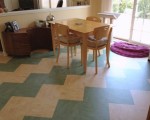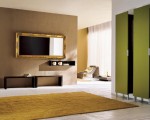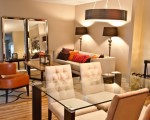Architecture
Designs of a lifetime
A lot of small things are associated with the interior of house. Here are some tips that would help you in the process of decking up the interior of your dream home.
First of all, you have to select a design that is affordable for your budget. It is better to give the task to an interior designer during the time of preparing basic architecture of villas. This will help you segregate electric and plumbing works according to the interior layout you opt for. By adopting unique design elements and design innovations you can give a unique character to the interior of your villa.
When you prepare interior layout it’s important to find more storage space inside. These storage spaces should be planned in a stylish and visually appealing manner. Creative shelves and sleek wardrobes can be given for storage. Sliding compartments can hide the sudden view. Sliding storage units are apt for kitchen and bathroom areas. This will give clutter-free interiors. Garden can be set up in the balcony of the villa. This will provide visual beauty. Along with this, ironing points and reading areas can be given (from outside view, these should not be visible at first look).
Living room design
Living area is a place where you expect full of light. During daytime, you will get natural air and at night the lighting will be an attraction. Big windows and ventilation will help get wind and natural light. Light colours, attractive lights will fill the room with necessary light. In fact, sofas and other furniture give life to drawing rooms. Beautifully upholstered sofa will double up the aesthetics of drawing room. Fully upholstered sofas can be in formal living and simple seats can be placed in family living. Sofas can be bought or manufactured by giving your favourite clothes.
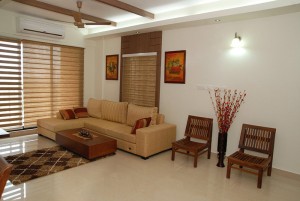 A clutter-free living room is the latest trend. Only necessary things can be placed there. A big upholstered sofa and two chairs will give a royal look to living room. Cushions will add beauty. Cushions with sequence work, mirror work and border are the latest trend. There is always demand for silk, cotton and jute. If you like greenery in the room, interior plants can be placed in the artificial courtyard beside living room. The favourite indoor plants are bamboo, African violet, white, red and pink colour orchids.
A clutter-free living room is the latest trend. Only necessary things can be placed there. A big upholstered sofa and two chairs will give a royal look to living room. Cushions will add beauty. Cushions with sequence work, mirror work and border are the latest trend. There is always demand for silk, cotton and jute. If you like greenery in the room, interior plants can be placed in the artificial courtyard beside living room. The favourite indoor plants are bamboo, African violet, white, red and pink colour orchids.
Wallpapers are innovations in living room. There are imported and washable wallpapers. These are used in sit-outs and living room. Wall clambings are also used commonly. Natural stones, tile, metal and glass are the trends in wall clambings. In old houses also clambings can be used.
A big mirror in a living room with light colour and beautiful lights is always good. It will fill positive energy and give a big look.
Presence of zig zag design prints is the latest trend in interior design. Apart from giving novel visual treat, this will evoke the feeling of large space. These designs are available in wallpapers, throw pillows, lamp shades, rushes and curtains etc.
Mirrors play is an important product in décor products. They provide a stylish and elegant look to the interiors. The wise use of zig zag mirrors and eclipse mirrors will certainly give an elegant look to your interiors. Fiction mirrors are another good product. It is more suitable on walls with a rough and look and in modern design interiors.
Modular lighting, folding and flexible designer lamps are excellent décor products. These products add beauty to the interior. Another addition to this is LED lamps which are beautiful and reduce use of electricity. Glare-free lights are the new addition in the LED lights series. It will be a little expensive than ordinary LED lights. LED designs like LED Mushroom lights, LED Moon lights and Wall Brights can be used in interiors.
Light automation means you can switch on the light without touching the switch! With the help of a mobile phone or laptop you can control the lights of your house from anywhere in the world. For example, you can set the time in the timer of the control unit when the lamps have to be lit. These lights function with the help of sensors. Light automation reduces electricity wastage. There are lights which can be controlled or changed their colours with the help of a remote control.
Cabin lighting
Lighting up the cabins is also a new trend in interiors. Kitchen cabins, wardrobes in bedroom and niche in living room come under cabin lighting. When you open the cabin it is automatically lit. This is possible with the help of sensors. Normally LED lights are used. As wiring is difficult inside cabins, special batteries are used. The batteries can work almost 10 hours. ‘Under Cabinet Lighting’ is a novelty in kitchen lighting. The light is fixed in an attractive way under the cabinet and counter top. Such light designs are suitable for open kitchens.
Painting
When it comes to interior painting, stencil design is the latest trend. After painting the room normally, stencil design is given in some places on the wall. The colour of the stencil design will be totally different from the colour used on wall. Stencil designs suitable for each room are available in the market now. If you want a particular design, paint companies will do it for you. All you have to do is to hand over the model of the design to the paint shop. With the help of computer, they will prepare your favourite stencil design. You can take a printout of the design too.
After painting the wall, stick “stencil sticker sheet” on the place where you want to place stencil. From this sheet, carefully remove the part that includes the design and then paint or spray the desired colour on the sticker. Later, when you remove the sheet from the wall, you will see stencil design perfectly placed on the wall.
With the advent of stencil, special effect painting has lost its popularity among people. The specialty of special effect painting is that the wall is fully painted in a particular way. Stencil painting is a little bit simpler and grand form when compared to special effect painting. A special type of polyurethane paint is available in the market now for painting furniture. This can be washed using water.
Metallic colours shine
Metallic colours are another innovation in interior designing. Such paints will have similarity to gold, silver and bronze colours. There are a few who mix other colours with metallic- “coloured metallics” style, and use it as designer painting.
Glitter and Glow
This is another newcomer in the paint market. Such paints will glitter according to the light. During daytime and night, these fluorescent paints will appear differently. Though these kinds of paints were used for children’s rooms before, now it’s been trying out in living rooms too.
Stone finish paints, which are normally used to paint the rough stones for wall cladding, are also getting wide currency in the paint market. These polyurethane paints make a cover on the stone and prevent dust and dirt sticking on the wall. Normally, the paint is sprayed on the stone. Compared to the white paints, there are special paints available for the ceiling. They are shiny, soft and waterproof.
Water-based paints
We can see companies vying for launching water-based paints. Easy usage is the specialty of these paints. By adding water the paint can be applied on the wall and there won’t be any foul smell like when we use turpentine. These paints are cost-effective when you consider square feet rate and it will last. Importantly, the family members also can paint using water-based paints. It doesn’t require any special skill. Even foreign companies advertise as “do it yourself”.
Architecture
Creating a Cozy Living Room: Tips for Comfort and Style

Your living room is more than just a space for entertaining; it’s a sanctuary where you unwind, relax, and spend quality time with loved ones. Creating a cozy living room involves a blend of comfort and style that makes the space inviting and functional. Here are some tips to help you achieve that perfect balance:
Choose the Right Furniture
Start with furniture that combines comfort and functionality. Opt for a plush sofa with deep cushions, perfect for lounging. Consider adding a cozy armchair or a recliner for additional seating. Make sure the furniture arrangement promotes conversation and allows for easy movement throughout the room.
Layer Your Lighting

Lighting plays a crucial role in setting the mood. Use a mix of lighting sources to create a warm ambiance. Combine overhead lights with floor lamps, table lamps, and wall sconces. For added coziness, incorporate dimmers or smart bulbs that let you adjust the brightness to suit different times of day and activities.
Add Textures with Throws and Pillows
Textures are key to a cozy living room. Layer different fabrics, such as soft throw blankets, plush pillows, and textured rugs. Choose fabrics like wool, velvet, and cotton that add warmth and comfort. Mix and match patterns and colors to create visual interest and a personalized touch.
Incorporate Warm Colors
Color influences the feel of a room. Opt for warm, neutral tones like beige, taupe, or soft gray for a calming effect. Accents in rich colors like deep blues, earthy greens, or warm terracotta can add depth and coziness. Use these colors in your furniture, accessories, and wall decor.
Use Rugs to Define Spaces

Rugs can help define different areas within a living room and add a layer of warmth underfoot. Choose a rug that complements your furniture and adds softness to the space. A large area rug can anchor the room, while smaller rugs can be used to highlight specific areas, like a reading nook or conversation zone.
Incorporate Natural Elements
Bring the outdoors in by incorporating natural elements. Plants not only add a touch of greenery but also improve air quality and create a calming atmosphere. Choose low-maintenance plants like succulents or snake plants if you’re not an avid gardener. Wooden furniture or decor pieces can also add a natural, grounded feel to the room.
Personalize with Artwork and Décor

Add personality to your living room with artwork and decorative items that reflect your style. Choose pieces that resonate with you, whether it’s family photos, abstract art, or vintage finds. Arrange decor items in groups to create visual interest and avoid clutter.
Create a Focal Point
A focal point helps draw the eye and creates a sense of balance in the room. This could be a fireplace, a statement piece of art, or a stylish coffee table. Arrange your furniture and decor around this focal point to enhance the room’s overall cohesion and appeal.
Invest in Quality Window Treatments
Window treatments can impact both the look and feel of your living room. Opt for curtains or blinds that provide privacy while allowing natural light to filter through. Choose fabrics that complement your decor and add texture, such as linen or velvet.
Add Personal Touches
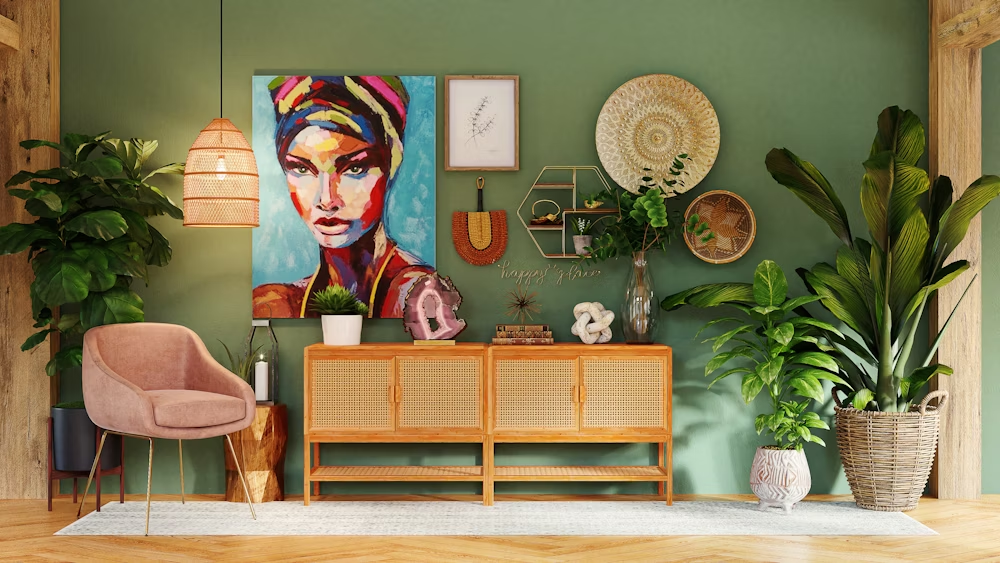
Finally, make the space truly yours by adding personal touches. Incorporate items that have sentimental value or reflect your interests and hobbies. Whether it’s a collection of travel souvenirs, a beloved quilt, or unique decorative objects, these elements will make your living room feel more inviting and personal.
By thoughtfully combining these elements, you can create a cozy living room that serves as a comfortable retreat and a stylish gathering place for friends and family. Enjoy the process of making your space uniquely yours and revel in the comfort and warmth it provides.
Architecture
The Art of Feng Shui: Creating Harmony in Your Home

Feng Shui, an ancient Chinese art and science, is all about creating harmony and balance in our living spaces. By arranging our homes in accordance with Feng Shui principles, we can invite positive energy, known as “chi,” into our lives and promote health, wealth, and happiness. In this blog post, we’ll explore the fundamentals of Feng Shui and share practical tips for applying its principles to create a harmonious and inviting home environment.
Understanding the Basics of Feng Shui:
Feng Shui is based on the concept of “chi,” or life force energy, which flows through our environments and influences our well-being. The goal of Feng Shui is to create a harmonious flow of chi by arranging our surroundings in a way that promotes balance and harmony. This includes paying attention to the layout, orientation, and organization of our homes to optimize the flow of energy.
The Five Elements of Feng Shui:
In Feng Shui, there are five elements—wood, fire, earth, metal, and water—that represent different qualities and energies. By incorporating these elements into our home decor, we can create a sense of balance and harmony. For example, wood represents growth and vitality, while water symbolizes flow and abundance. By incorporating a balance of these elements into our living spaces, we can enhance the flow of positive energy and create a sense of equilibrium.
Applying Feng Shui Principles to Your Home:
Clearing Clutter: Clutter can block the flow of chi and create stagnant energy in our homes. Start by decluttering your space and getting rid of items that no longer serve a purpose. This will create space for fresh energy to flow and rejuvenate your home.
Balancing Yin and Yang: In Feng Shui, yin and yang represent the balance of feminine and masculine energies. Create a harmonious balance of yin and yang in your home by incorporating soft, nurturing elements (yin) with strong, active elements (yang).
Enhancing the Flow of Chi: Pay attention to the layout and arrangement of furniture in your home to optimize the flow of chi. Avoid placing furniture in direct line with doorways or blocking pathways, as this can disrupt the flow of energy. Instead, create open and inviting spaces that allow chi to circulate freely.
Incorporating Nature: Bring the outdoors in by incorporating elements of nature into your home decor. Plants, natural materials, and natural light can enhance the flow of chi and create a sense of vitality and well-being in your living spaces.
Room-By-Room Feng Shui Tips:
Living Room: Arrange furniture in a circular or semi-circular layout to encourage conversation and social interaction. Use soft, natural fabrics and incorporate elements of wood and fire to create warmth and intimacy.
Bedroom: Position your bed diagonally across from the door to command a clear view of the room while you sleep. Keep the space under your bed clear and clutter-free to promote restful sleep and relaxation.
Kitchen: Keep your kitchen clean, organized, and clutter-free to promote health and abundance. Incorporate elements of fire and earth, such as candles and earthy tones, to create a warm and inviting atmosphere for cooking and dining.
By incorporating the principles of Feng Shui into your home decor, you can create a harmonious and balanced living environment that supports your health, happiness, and overall well-being. Whether you’re decluttering your space, balancing yin and yang energies, or enhancing the flow of chi, the art of Feng Shui offers timeless wisdom and practical guidance for creating a sanctuary of peace and tranquility in your home.
Architecture
5 Sustainable Interior Design Trends to Embrace in 2024

As the world becomes increasingly aware of the importance of sustainability, it’s no surprise that eco-friendly practices are making their way into the realm of interior design. In 2024, we can expect to see a surge in sustainable interior design trends that not only enhance the beauty of our living spaces but also minimise our environmental footprint. From repurposed materials to energy-efficient solutions, here are five sustainable interior design trends to embrace this year.
Upcycled Furniture:

One of the most prominent sustainable interior design trends of 2024 is the use of upcycled furniture. Instead of buying new pieces, consider giving old furniture a new lease on life by refurbishing or repurposing them. From reclaimed wood tables to refurbished chairs, upcycled furniture adds character and charm to your space while reducing waste and conserving resources.
Biophilic Design:

Biophilic design, which emphasizes a connection to nature, continues to gain popularity in 2024. Integrating natural elements such as plants, natural light, and organic materials into your interior design not only enhances aesthetics but also promotes well-being and sustainability. Consider incorporating living walls, indoor gardens, and sustainable wood finishes to bring the outdoors inside and create a healthier living environment.
Energy-Efficient Lighting:

With a growing focus on energy conservation, energy-efficient lighting solutions are becoming a staple in sustainable interior design. LED lights, in particular, consume significantly less energy than traditional incandescent bulbs and last much longer, reducing both energy consumption and maintenance costs. Additionally, consider incorporating natural light sources such as skylights and large windows to maximize daylight and minimize the need for artificial lighting during the day.
Sustainable Textiles:

When it comes to upholstery and soft furnishings, opting for sustainable textiles is key to reducing environmental impact. Look for fabrics made from organic or recycled materials, such as organic cotton, hemp, bamboo, or recycled polyester. These materials not only reduce the use of harmful chemicals and pesticides but also minimize waste and support eco-friendly production practices. Additionally, consider investing in durable, high-quality textiles that stand the test of time, reducing the need for frequent replacements.
Smart Home Technology:

In 2024, smart home technology continues to evolve, offering innovative solutions for sustainable living. From smart thermostats that optimize energy usage to home automation systems that control lighting and appliances, these technologies can help reduce energy consumption and increase efficiency in your home. Additionally, smart home devices such as occupancy sensors and smart meters provide valuable insights into your energy usage, empowering you to make informed decisions about resource management and conservation.
As we strive to create more sustainable living environments, embracing these five interior design trends can help reduce our environmental impact while creating beautiful and functional spaces. Whether you’re upcycling old furniture, incorporating natural elements, or investing in energy-efficient technologies, every sustainable choice contributes to a greener future for generations to come. So let’s embrace these trends and make sustainability a cornerstone of our interior design practices in 2024 and beyond.
-

 Style11 months ago
Style11 months agoBridal Guide : Best Looks of Radhika Merchant Ambani
-

 Entertainment1 year ago
Entertainment1 year agoThe Stunning looks from Bhagya Suresh’s Wedding
-

 Fashion1 year ago
Fashion1 year agoMost Discussed Ajrakh Saree of Alia Bhatt
-

 Entertainment1 year ago
Entertainment1 year agoThe Most Stylish Guests of Bhagya Suresh Reception
-

 Entertainment1 year ago
Entertainment1 year agoBridal Bliss : All Bridal Looks of Swasika Vijay
-

 Movies1 year ago
Movies1 year agoA Nostalgic Journey Through Love &Cinema : Best Bollywood Romantic 90s Movies
-

 Fashion1 year ago
Fashion1 year agoMajor Denim Trends You Need To Know in 2024
-

 AD8 months ago
AD8 months agoPopular Curtain Fabrics to Consider for Your Home

